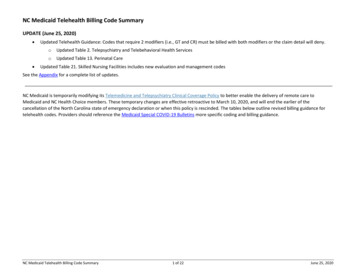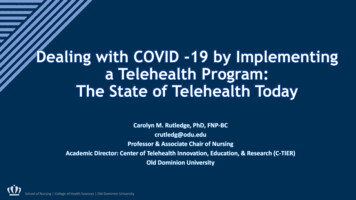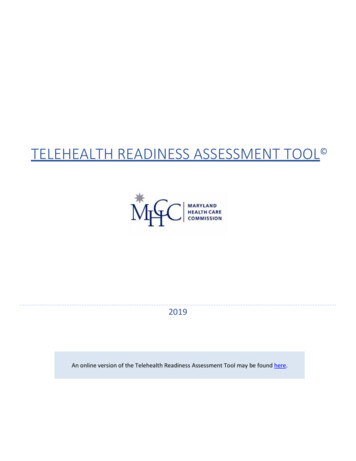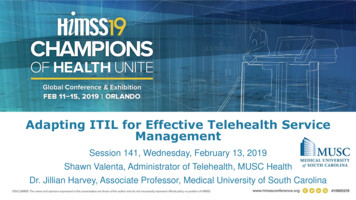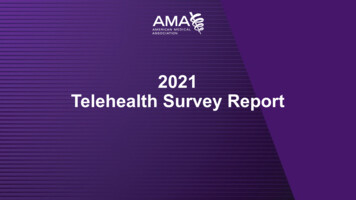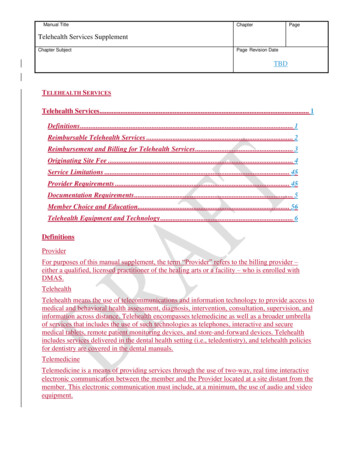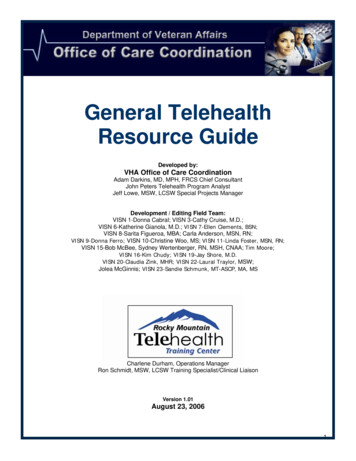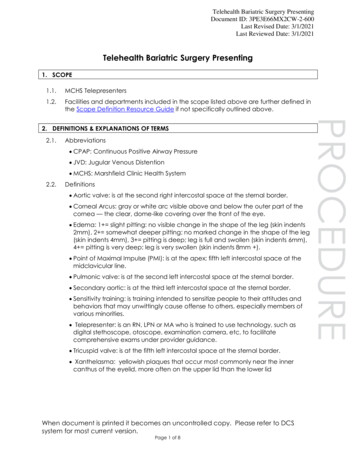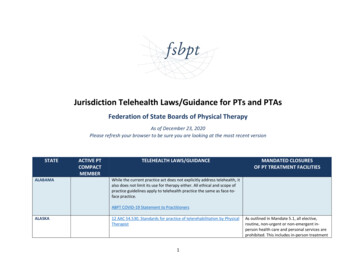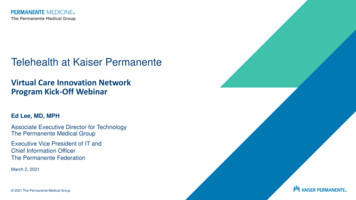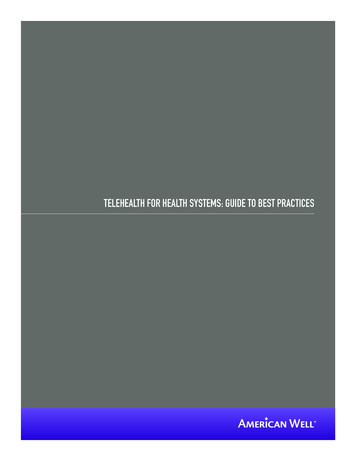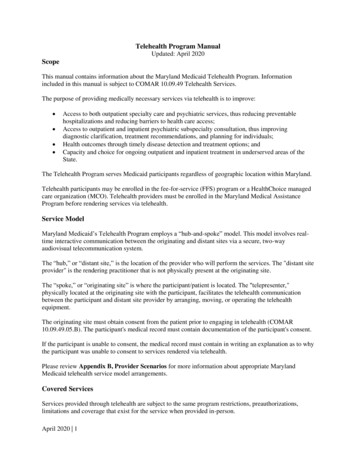
Transcription
Telehealth Program ManualUpdated: April 2020ScopeThis manual contains information about the Maryland Medicaid Telehealth Program. Informationincluded in this manual is subject to COMAR 10.09.49 Telehealth Services.The purpose of providing medically necessary services via telehealth is to improve: Access to both outpatient specialty care and psychiatric services, thus reducing preventablehospitalizations and reducing barriers to health care access;Access to outpatient and inpatient psychiatric subspecialty consultation, thus improvingdiagnostic clarification, treatment recommendations, and planning for individuals;Health outcomes through timely disease detection and treatment options; andCapacity and choice for ongoing outpatient and inpatient treatment in underserved areas of theState.The Telehealth Program serves Medicaid participants regardless of geographic location within Maryland.Telehealth participants may be enrolled in the fee-for-service (FFS) program or a HealthChoice managedcare organization (MCO). Telehealth providers must be enrolled in the Maryland Medical AssistanceProgram before rendering services via telehealth.Service ModelMaryland Medicaid’s Telehealth Program employs a “hub-and-spoke” model. This model involves realtime interactive communication between the originating and distant sites via a secure, two-wayaudiovisual telecommunication system.The “hub,” or “distant site,” is the location of the provider who will perform the services. The "distant siteprovider" is the rendering practitioner that is not physically present at the originating site.The “spoke,” or “originating site” is where the participant/patient is located. The "telepresenter,"physically located at the originating site with the participant, facilitates the telehealth communicationbetween the participant and distant site provider by arranging, moving, or operating the telehealthequipment.The originating site must obtain consent from the patient prior to engaging in telehealth (COMAR10.09.49.05.B). The participant's medical record must contain documentation of the participant's consent.If the participant is unable to consent, the medical record must contain in writing an explanation as to whythe participant was unable to consent to services rendered via telehealth.Please review Appendix B, Provider Scenarios for more information about appropriate MarylandMedicaid telehealth service model arrangements.Covered ServicesServices provided through telehealth are subject to the same program restrictions, preauthorizations,limitations and coverage that exist for the service when provided in-person.April 2020 1
Somatic services: Providers must contact the participant's Healthchoice MCO with questions regardingprior authorization requirements for services rendered via telehealth.Behavioral services: Providers must contact the behavioral health ASO with questions regarding priorauthorization requirements for services rendered via telehealth.Participant EligibilityA participant is eligible to receive services via telehealth if the individual: Is enrolled in the Maryland Medical Assistance Program on the date the service is rendered;Consents to service rendered via telehealth (unless there is an emergency that prevents obtainingconsent);Is present at the originating site at the time the service via telehealth is rendered; andIs authorized to receive services, except for services provided in a hospital emergencydepartment.Eligible ProvidersOriginating SitesThe following provider types may act as originating sites for telehealth: A college or university student health or counseling office;A community-based substance use disorder provider;A deaf or hard of hearing participant’s home or any other secure location as approved by theparticipant and the provider;An elementary, middle, high, or technical school with a supported nursing, counseling or medicaloffice;A local health department;A Federally Qualified Health Center (FQHC);A hospital, including the emergency department;A nursing facility;A private office (physician, physician assistant, psychiatric nurse practitioner, nurse practitioner,or nurse midwife);An opioid treatment program;An outpatient mental health center (OMHC);A renal dialysis center; orA residential crisis services siteDistant sitesEffective October 7, 2019, all distant site providers enrolled in Maryland Medicaid may provide servicesvia telehealth as long as telehealth is a permitted delivery model within the rendering provider’s scope ofpractice. Providers should consult their licensing board prior to rendering services via telehealth.Technical RequirementsApril 2020 2
A telehealth provider must use technology that supports the standard level of care required to deliver theservice rendered. Providers shall, at a minimum, meet the following technology requirements:1. A camera that has the ability to manually, or under remote control, provide multiple views of apatient with the capability of altering the resolution, focus, and zoom requirements according tothe consultation;2. Have display monitor size sufficient to support diagnostic needs used in the service via telehealth;3. Bandwidth speed and image resolution sufficient to provide quality video to meet a minimum of15 frames per second, or higher, as industry standards change;4. Unless engaging in a telehealth communication with a participant who is deaf or hard of hearing,audio equipment that ensures clear communication and includes echo cancellation;5. Creates audio transmission with less than 300 millisecond delay;6. Secured and HIPAA compliant telehealth communication (COMAR 10.09.36 General MedicalAssistance Provider Participation Criteria).A dedicated connection that provides bandwidth only for telehealth communications is preferable forservices delivered via telehealth.All technical staff must be trained in telehealth technology use and HIPAA Compliance.Please review Maryland Medicaid’s FAQs for additional technological and HIPAA Compliancequestions.ReimbursementTelehealth providers submit claims in the same manner the provider uses for in-person services. Providersmust include the “GT” modifier to identify services rendered via telehealth.Only providers who are HIPAA compliant and meet Technical Requirements may bill for servicesrendered via telehealth.Providers should use the place of service code that would be appropriate as if it were a non-telehealthclaim. The distant site should use the location of the doctor. If a distant site provider is rendering servicesat an off-site office, use place of service office (11). Place of Service Code 02 (Telehealth) is notrecognized for Maryland Medicaid participants except for use on Medicare crossover claims to specifyservices rendered through a telecommunication system for dual eligible participants. Allowable place ofservice codes should remain unchanged for Medicaid-only claims.As explained above, services provided via telehealth must be provided through two-way audio-visualtechnology assisted communication with the participant who is physically located at a permittedoriginating site.LimitationsThe Program will not reimburse telehealth providers for the following: When technical difficulties prevent the delivery of part or all of the telehealth session;Consultation that occurs during ambulance transport;Services that require in-person evaluation or cannot be reasonably delivered via telehealth;Use of services rendered via telehealth for home health monitoring;April 2020 3
Use of store-and-forward service delivery models1;Telecommunication between providers without the participant present;An audio-only conversation between a provider and participant;An electronic mail message between a provider and participant;A facsimile transmission between a provider and participant;A telephone conversation, electronic mail message, or facsimile transmission between theoriginating and distant site providers; orConfidentialityBoth originating and distant site providers must comply with the laws and regulations concerning theprivacy and security of protected health information under Health-General Article, Title 4, Subtitle 3,Annotated Code of Maryland and the Health Insurance Portability and Accountability Act (HIPAA) of1996. Particularly, providers:1. Shall ensure that all interactive video technology-assisted communication complies with HIPAApatient privacy and security regulations at the originating site, the distant site, and thetransmission process;2. May not disseminate any participant images or information to other entities without theparticipant’s consent, unless there is an emergency that prevents obtaining consent; and3. May not store at originating or distant sites the video images or audio portion of the servicerendered via telehealth for future use.Medical RecordsThe originating and distant site providers must maintain documentation in the same manner as during anin-person visit or consultation, using either electronic or paper medical records, per the Health-GeneralArticle, §4-403, Annotated Code of Maryland. Participants shall have access to all transmitted medicalinformation, with the exception of live, interactive video, as there is often no stored data in suchencounters.Reminder: originating site providers must document, in the participant’s medical record, the participant’ssigned consent or the emergency situation that prevented obtaining consent from the participant prior todelivering services via telehealth.1Store and Forward technology means the transmission of medical images or other media captured by theoriginating site provider and sent electronically to a distant site provider, who does not physically interactwith the patient located at the originating site. It is not covered under Maryland Medicaid’s Telehealthprogram, but is covered for dermatology, ophthalmology, or radiology services under the PhysicianServices at COMAR 10.09.02.07.April 2020 4
Appendix A: MCO and ASO ContactsAetna Better Health:Cheryl Toland, COOAetna Better Health of MarylandPhone: 443-457-5293 or 443-370-8975Amerigroup Community Care:For preauthorization and administrative questions: 800-454-3730Kathleen Harmon RN Director I, Clinical OperationsO: (410) 981-4069 F: (844) 887-6353Jai Medical Systems:Helena Manu, Director, Provider RelationsPhone: 410-433-2200Email: Helena@jaimedical.comKaiser Permanente:Doug Ingalls, Manager, Medicaid nd Physicians Care (MPC):Jeanne Hamilton Manager Compliance-Maryland Physicians CarePhone: 443-713-4799Email: r Family Choice:For preauthorization: Care Management: 800-908-1722For enrollment: Lesley Wallace, VP Government Contract Management & OversightEmail: Lesley.Wallace@medstar.netPhone: 410-933-3013Priority Partners:Kayode Williams, MDPhone: 410-955-1822Email: kwilli64jhmi.eduAdministrative questions: Kathy PettwayEmail: kpettwa@jhhc.comUniversity of Maryland Health Partners:Dan Myers. VP of ril 2020 5
United Healthcare:Members: 800-318-8821Providers: 877-842-3210Optum:Provider Enrollment: 1-844-463-7768Recipient Enrollment: 1-855-642-8572EVS – Eligibility Verification: 1-866-710-1447Optum (toll-free, follow prompts): 1-800-888-1965, TTY 711Fax: 1-855-293-5407Email: marylandproviderrelations@optum.comApril 2020 6
Appendix B: Provider ScenariosScenario One: Appropriate Use of Telehealth – Somatic ServicesA 16-year-old boy comes into his pediatrician’s office for a sick visit. His symptoms align with bothIrritable Bowel Syndrome (IBS) and Crohn’s Disease. There are several tests available for narrowingdown the diagnosis, but his doctor is unsure which is appropriate. The pediatrician acts as the originatingsite and connects with his gastroenterologist telehealth partner at a regional academic medical center, thedistant site. The gastroenterologist is located hours away from the boy and his pediatrician. Throughtelehealth audio/video technology-assisted communication, the gastroenterologist is able to examine theboy.The gastroenterologist examines the boy’s medical record, which the pediatrician shares through a secureportal. After asking the patient a series of questions about his symptoms and eating habits, the two doctorsare able to discuss options for testing, share opinions, and decide upon the most appropriate diagnostictest. The pediatrician may bill the appropriate E&M code for the in-person services delivered. Thegastroenterologist may bill the E&M code and must use the “-GT” modifier in order to identify the claimas a telehealth delivered service.Scenario Two: Appropriate Use of Telehealth – Behavioral Health ServicesA participant visits a Student Health Counseling Office for a therapy session. During the session, thesocial worker (LCSW-C) determines that a telehealth consultation with a psychiatrist is necessary todiscuss the participant’s medication. The LCSW-C sets up a telehealth consultation with a psychiatrist ata distant site. The psychiatrist confers with the participant about her current medication. The LCSW-Cdoes not participate in the telehealth session with the participant, but enables the telehealth session byinitiating the connection.Following the telehealth session, the psychiatrist may bill the appropriate E&M code and must use the “GT” modifier in order to identify the claim as a telehealth delivered service.Scenario Three: Appropriate Use of Telehealth – Buprenorphine ServicesAn individual with a diagnosed opioid use disorder is identified as a good candidate for, and has electedto use, buprenorphine to help in his/her recovery. The individual is seen by a community-based substanceuse disorder provider. The community-based substance use disorder provider coordinates buprenorphineservices with a DATA 2000 waiver provider who is enrolled with Medicaid and registered with the ASO.The physician or nurse practitioner, who is located at a distant site, may bill for the appropriate E&Mcodes for induction and maintenance using the –GT modifier to identify the claim as a service deliveredvia telehealth.Prior to rendering services, the community-based substance use disorder provider obtains authorizationfor their services through the ASO. The Physician billing for buprenorphine must obtain authorization tobill the E&M codes. The level of intensity of the E&M code should be congruent with the clinical level ofneed and will be subject to review.Scenario Four: Appropriate Use of Telehealth – FQHCAn individual receives medical care at an FQHC, and during the course of treatment, receivesauthorization for psychiatric services. The FQHC does not have a clinical psychiatrist on staff to treat thepatient, but connects with a distant site psychiatrist to render psychiatric care. The FQHC treats theApril 2020 7
patient for other wraparound services it can perform under its onsite clinical staff and bills Medicaidnormally for its approved federally qualified rate. The distant site psychiatrist office bills Medicaid for theappropriate E&M code with the -GT modifier.April 2020 8
Helena Manu, Director, Provider Relations Phone: 410-433-2200 Email: Helena@jaimedical.com Kaiser Permanente: Doug Ingalls, Manager, Medicaid Operations 301-816-6148 Douglas.ingalls@kp.org Maryland Physicians Care (MPC): Jeanne Hamilton Manager Compliance-Maryland Physicians Care Phone: 443-713-4799
